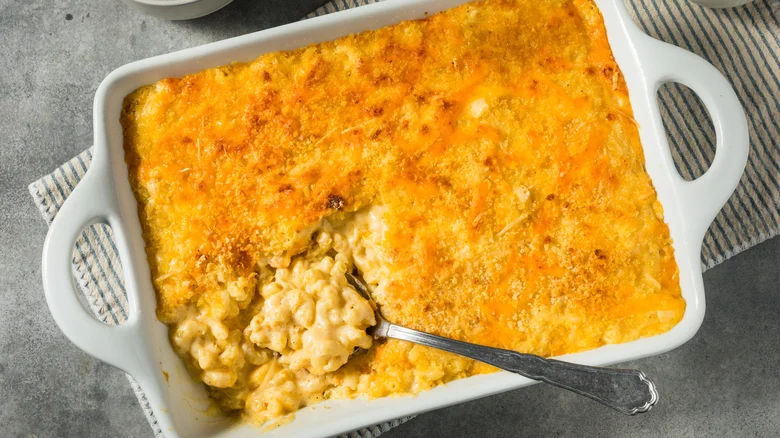Bhofack2/Getty Images
Boxed or homemade, stovetop or baked, in some form or other mac and cheese has many fans. If you’re looking to upgrade this pasta dish, a different classic comfort food might help: cream of mushroom soup. Well-established as a casserole base, cream of mushroom soup can add a little extra richness and a hint of umami flavor. While it may be an ingredient you never thought to put in mac and cheese, tons of posts on TikTok indicate this canned food combination is having its moment……..Continue reading….
By: Erin Wisti
Source: Mashed
.
Critics:
It is often claimed that spices were used either as food preservatives or to mask the taste of spoiled meat, especially in the European Middle Ages. This is false. In fact, spices are rather ineffective as preservatives as compared to salting, smoking, pickling, or drying, and are ineffective in covering the taste of spoiled meat.
Moreover, spices have always been comparatively expensive: in 15th century Oxford, a whole pig cost about the same as a pound of the cheapest spice, pepper. There is also no evidence of such use from contemporary cookbooks: “Old cookbooks make it clear that spices weren’t used as a preservative. They typically suggest adding spices toward the end of the cooking process, where they could have no preservative effect whatsoever.”
The control of trade routes and the spice-producing regions were the main reasons that Portuguese navigator Vasco da Gama sailed to India in 1499. When da Gama discovered the pepper market in India, he was able to secure peppers for a much lower cost than demanded by Venice. At around the same time, Christopher Columbus returned from the New World. He described to investors the new spices available there.
Another source of competition in the spice trade during the 15th and 16th centuries was the Ragusans from the maritime republic of Dubrovnik in southern Croatia. The military prowess of Afonso de Albuquerque (1453–1515) allowed the Portuguese to take control of the sea routes to India. In 1506, he took the island of Socotra in the mouth of the Red Sea and, in 1507, Ormuz in the Persian Gulf.
Since becoming the viceroy of the Indies, he took Goa in India in 1510, and Malacca on the Malay Peninsula in 1511. The Portuguese could now trade directly with Siam, China, and the Maluku Islands. With the discovery of the New World came new spices, including allspice, chili peppers, vanilla, and chocolate. This development kept the spice trade, with the Americas as a latecomer with their new seasonings, profitable well into the 19th century.
A study by the Food and Drug Administration of shipments of spices to the United States during fiscal years 2007–2009 showed about 7% of the shipments were contaminated by Salmonella bacteria, some of it antibiotic-resistant. As most spices are cooked before being served salmonella contamination often has no effect, but some spices, particularly pepper, are often eaten raw and are present at the table for convenient use.
Shipments from Mexico and India, a major producer, were the most frequently contaminated. Food irradiation is said to minimize this risk. A mortar and pestle is the classic set of tools for grinding a whole spice. Less labor-intensive tools are more common now: a microplane or fine grater can be used to grind small amounts; a coffee grinder is useful for larger amounts. A frequently used spice such as black pepper may merit storage in its own hand grinder or mill.
The flavor of a spice is derived in part from compounds (volatile oils) that oxidize or evaporate when exposed to air. Grinding a spice greatly increases its surface area and so increases the rates of oxidation and evaporation. Thus, the flavor is maximized by storing a spice whole and grinding when needed. The shelf life of a whole dry spice is roughly two years; of a ground spice roughly six months.
The “flavor life” of a ground spice can be much shorter. Ground spices are better stored away from light. Some flavor elements in spices are soluble in water; many are soluble in oil or fat. As a general rule, the flavors from a spice take time to infuse into the food so spices are added early in preparation. This contrasts to herbs which are usually added late in preparation.
Herbs and Spices – Biomarkers of Intake Based on Human Intervention Studies – A Systematic Review”.
Spice – Middle English Compendium”.
Berenike and the Ancient Maritime Spice Route.
Bible Gateway passage: Song of Songs 4:14 – New International Version”.
CRC Handbook of Medicinal Spices.
Tastes of paradise : a social history of spices, stimulants, and intoxicants.
How a full spice cabinet can keep you healthy”.
Can we understand modern humans without considering pathogens?: Human evolution and parasites”.
Spice and herb | Types, Uses, & Facts |
Herbs and Spices – Biomarkers of Intake Based on Human Intervention Studies – A Systematic Review”.
Spice – Middle English Compendium”.
Berenike and the Ancient Maritime Spice Route.
Bible Gateway passage: Song of Songs 4:14 – New International Version”.
CRC Handbook of Medicinal Spices.
Tastes of paradise : a social history of spices, stimulants, and intoxicants.
How a full spice cabinet can keep you healthy”.
Can we understand modern humans without considering pathogens?: Human evolution and parasites”.
Salmonella in Spices Prompts Changes in Farming”. “
Production of Spice by countries”. UN Food & Agriculture Organization.
Spices and condiments. Food additives”
Salmonella in Spices Prompts Changes in Farming”. “
Production of Spice by countries”. UN Food & Agriculture Organization.
Spices and condiments. Food additives”
.
.
labels: Spices,condiments, additives,pathogens,parasites,antimicrobial,intoxicants,Herbs,Biomarkers,Intervention,microbiome,cancer,Parkinson






Leave a Reply